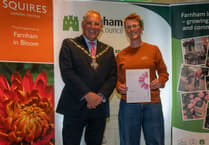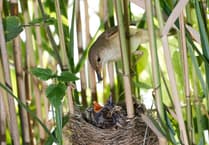When I was a young boy I was addicted to a table top football game called Subbuteo, without ever wondering about the origin of the name, writes Alan Wynde.
My school friends and I set up leagues and particularly looked forward to local derby games. Coming from the West Midlands, the Black Country grudge matches between the Baggies and Wolves were eagerly anticipated.
As birding became more important than table top footie, I learned through a bird book the Latin name of the Hobby is Falco Subbuteo.
The game’s designer, Peter Adolph, was a keen ornithologist and wanted to call his game the Hobby, but this was considered too generic, so the classical name was used instead.
The Hobby is a summer visitor to the UK, and is one of our smallest raptors, with only the merlin being smaller.
It is an extremely swift and agile flyer, allowing it to hunt down insects, particularly dragonflies and even Swallows and Martins.
The Hobby is somewhere between a Swift and a Peregrine. It has the latter's black mustachio-like facial stripe and a falcon's sharp angled wings, but the former’s scimitar like profile in flight.
They are seen on an almost daily basis at Tice’s, which is a dragonfly haven, and is often spotted chasing juvenile Swallows and Martins.
If you peruse the Tice’s Meadow Facebook page you can see some brilliant photographs of Hobbys in hunting mode ,which give you a flavour of how agile they are. Most of them will have departed for their wintering grounds in Africa by the end of this month.
Why do they migrate? Why not stay in Sub Saharan Africa, where there is an abundant supply of insectivorous food all year round?
The reason for the pull to the north is all to do with hours of daylight, which is hugely increased in the north in summer, giving more hours of daylight to find a mate, breed and rear young. So, why not stay here then?
The general rule of thumb for raptors is that if your prey is warm blooded, then stay, but if it is cold blooded, then it’s migration or starvation, because your food supply dries up in the winter.
Hobbies, Honey Buzzards and Osprey all migrate, Kestrels, Sparrowhawks and Buzzards all stay.
The increase in dragonfly numbers in recent years has been important in enabling the Hobby's breeding success to improve and the bird has spread from its heartlands of the Downs and Heathlands of Southern England northwards. The BTO now estimate that 2,800 pairs now nest in England
In its winter quarters the Hobby becomes a rain bird, following the rain clouds that sweep south through Southern Africa, which release vast numbers of insects and the pickings are easy. The Hobby becomes an insect eater exclusively during this time.
So, do try and visit Tice’s and attempt to see this cracking little bird while it is still here. There are usually some very competent birders around and they will be only too happy to help you.







Comments
This article has no comments yet. Be the first to leave a comment.